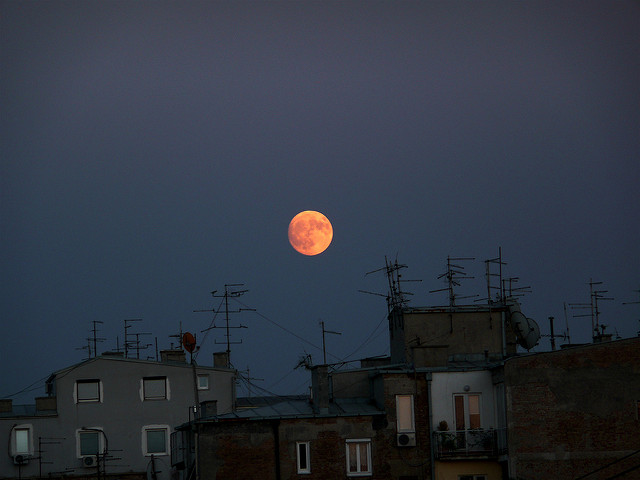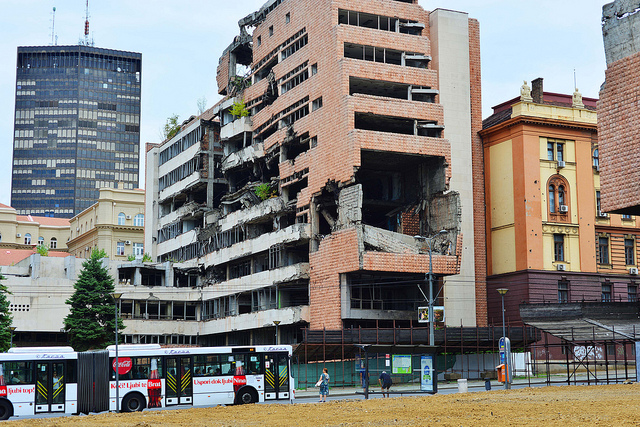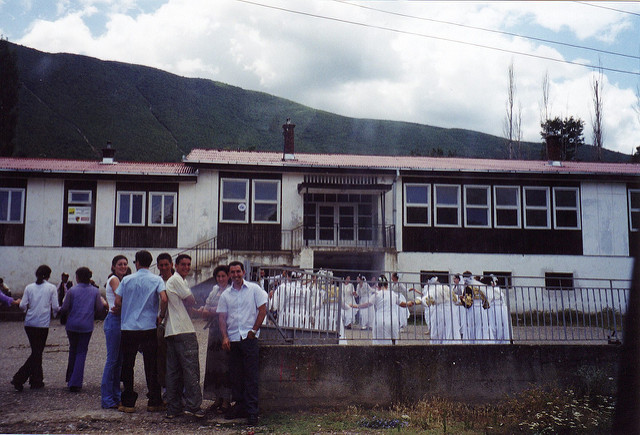
The town of Novi Sad, which lies about an hour outside of Belgrade, is home to three architectural paradoxes: a fortress for a city that has never been under attack, a Catholic Church with all the trimmings of Eastern Orthodoxy, and rows of pastel apartments that can neither be inhabited because of their historical preservation status nor restored because the Serbian government lacks the funds to do so. The wind idles through them, laughing at the potential for life that is frozen in the sticky windowpanes, caught between a turbulent past and a stagnant present.
Serbia and its neighbors exist in a post-war Twilight Zone, where the average salary is 400€ ($445 USD) a month but state of the art gyms use newer equipment than both Arrillaga facilities; where the English-speaking West has condensed its experience into one word: “balkanize (v.), to break up (as a region or group) into smaller and often hostile units.” For most Americans, the Balkans are either the place where the countries always change names (a Serbian born in 1988 who never moved from her hometown has lived in four countries) or the place where some bad things happened in the 1990s and ended with a slew of NATO bombings. Either way, they do not know that it is always better to snack on fresh popcorn from the stands that line the streets than to pretzels from grocery stores that are most often stale, or how to enjoy a shot of rakija (plum brandy) that burns like shame or pride, or sometimes both. They do not know that Serbia has ninety-nine problems—and Kosovo is one, but only one. Corruption, systemic misogyny, and an uncertain path towards European Union integration are a few more. Why should they know? This is a nation always in flux, whose two biggest global contributions are perpetrating the worst war crimes of the past twenty-five years and being the top exporter of raspberries. If its “Brain Drain” of highly educated, successful young people continues, it may become a top exporter of students as well. What 20-something comes back to a city pockmarked by bombs and disfigured by the leadership of the same politicians who supported Milošević’s regime of terror?

Neda. Ivana. Vlad. Dunja. Mina. Bojana. They are the ones who came back. On my four-day Stanford field trip to Belgrade, these were the names and faces that brought the sights, information, and paradoxes of Serbia together and made them real. They are the full manifestations of the vibrancy I glimpsed in the unnamed faces of other young people throughout the city, dancing on the hill of Kalemegdan at night, laughing at our response to a Billie Jean x. Milkshake remix at the club, strutting in sexy black outfits and furry boots that peaked in American popularity in the mid-2000s. This is a country so literally torn that its language is even caught in a tug of war—called Serbian in Serbia, Croatian in Croatia, it is the same incomprehensible syllabic patterns to an English speaker who had only ever been exposed to romance languages like me. But the students who gave us tours and chatted with us at dinner shared more than the balkanization of their lands and their cultures.
“It breaks my heart,” she says with a smile. “You see Romanov children in the street following their horses home to neighborhoods where no one else will live. I gave a refugee woman shoes for her baby and she cried. I almost cried. There are so many other problems in Serbia that the world doesn’t know. But it breaks my heart that they also don’t know about the good things.”
She pulls out her phone to show me photos from her friend’s wedding last weekend.
“The best man buys the bride from her family by shooting an apple off a tall pole,” she tells me.
Buys. I thought of the bathrooms in the restaurant we were sitting in. Straight from Pinterest, the DIY frames turned everyday objects into signs that translate across all languages—a blue tie on the men’s room door, a lacy bra on the women’s. Not to be confused with the signs from an office we had visited earlier that day, which stuck to the more basic Microsoft Word shapes and thought bubbles. Rectangle. Circle. “Football…” Triangle. Circle. “Shopping…” I washed my hands, hoping to also wash away the crawling sensation down my back that followed my slight, hard swallow upon seeing those signs.
Do they even play football in Serbia? The collegiate Tommy Hilfiger ads make it seem that way.

I don’t want those bathroom signs to be real. I don’t want to think about the way an engineering professor looked over my female friend’s head when she asked, as a fellow engineer, about his work, to lock eyes with the nearest male and say “Aren’t the women here beautiful?”. I don’t want him, or the bathroom signs, to ruin a culture for me. I can’t forget about them, but I can focus on the nuance. According to the photos, buying the bride is followed by non-stop dancing and laughing. But my lesson in Serbian wedding traditions was interrupted by a six-piece band strumming their guitars and transitioning from Serbian folk music to “Hit the Road, Jack.” Of course we sang along, and continued to when they played “Oh Susannah” and “When the Saints Go Marching In.” Eventually the music and plates of grilled meat became stifling, and I left the restaurant for what people thought was a smoke break but was really a literal run around the Skadarlija neighborhood, to feel the cold and the wind and the freedom that had so quickly been drained from me after a few too many hours in hot restaurants. How hard it must be to breathe after a few too many years of suffocation.
When my jog slowed to a walk and I started paying more attention to my surroundings, I found myself in front of an art gallery that appeared closed. But my knock on the door was answered by a woman wearing a satin black blouse that blended into her wild black hair. Laughter rang in her every word. We spoke in smiles, gestures, and some English.
“I make babies!” she said.
After some raised eyebrows and laughter, her career became clear. A gynecologist. She was a gynecologist/artist/art collector, and the pieces overflowing her gallery were all by Serbian artists.
People like her must be the breaths of fresh air that keep my new student friends from suffocating. When you go to teaching school to make a difference in children’s lives and your teaching manuals are from the 1960s, or when you go to law school to make a difference in a messy and corrupt political system and your textbooks are from the 1990s, it’s easy to give up. But there are so many who don’t, and their vibrancy radiates from their perfect English and their excitement to speak it, to the perfectly braided hair and traditional costumes they wear for competitions in national Serbian dancing. For every close-minded man in a tracksuit, there is a kind girl sharing her Kinder chocolate across the table. For every vain woman taking advantage of American male naivety, there is a star math student who volunteers at his former elementary school. There are even attention seeking women who are also brilliant biologists and have a special place in their hearts for their pet tarantulas (despite once being bitten and paralyzed for days). Because people, and places, are nuanced—an obvious fact that is too easy to forget from the comfortable ignorance of America, especially when the world has put Serbia out of the spotlight in favor of more pressing crises.
“This is not a society of dialogue,” I hear in some form or another from every young person we meet.
But it is a society of constant readjustment, of shedding its skin and experiencing the growing pains of integrating tradition with progress. It is a society of warmth and welcoming, because sometimes the answers don’t lie in dialogue. Sometimes the answers lie in dance.

Photos courtesy of here, here, here, here and author

jj
March 2, 2016 at 12:58 pm (1 year ago)I’d like to point out that many of those “war crimes” blamed on Serbs were propaganda or staged. UN officers who lived in Sarajevo witnessed Bosnian Muslim forces sniping and mortaring civilians in Sarajevo to have Serbs automatically be blamed.
Also, census records show it was the Serbs who were the most ethnically cleansed people of the wars. The others, that Serbs allegedly ethnically cleansed, ended up the same or greater percentage at war’s end.
Fact is that the U.S. was covertly, before overtly, supporting non-Serb separatists and, it, along with Germany and many other countries, were smuggling weapons to the Croats and Muslims despite the arms embargo.
Weapons were flowing in very heavily to the Bosnian Muslims. Even UN documents show this.
Also UN documents show it was the Bosnian Muslim government, under un-elected President Alija Izetbegovic, which was keeping most all the UN food getting to Sarajevo, away from the civilians, and instead was stockpiling it. This was acknowledged by UN officers at the ICTY. They confirmed that 60% of the UN food was kept by the government and not distributed.
Of the food that was distributed, most all of it went to the Bosniak forces or the black market. The government also interfered with the utilities more than the fighting itself. So in fact, the government purposely restricted food and interfered with the utilities to increase the victim hood status and blame Serbs to help sell the war and demonize them.
James R. Davis, a Canadian soldier in Sarajevo, said that the Bosniaks did mortar their own children and blame the Serbs. He called them “animals” in his book, “The Sharp End: A Canadian Soldier’s Story”.
All Americans (U.S.) did is lie about Serbs and did so much harm.